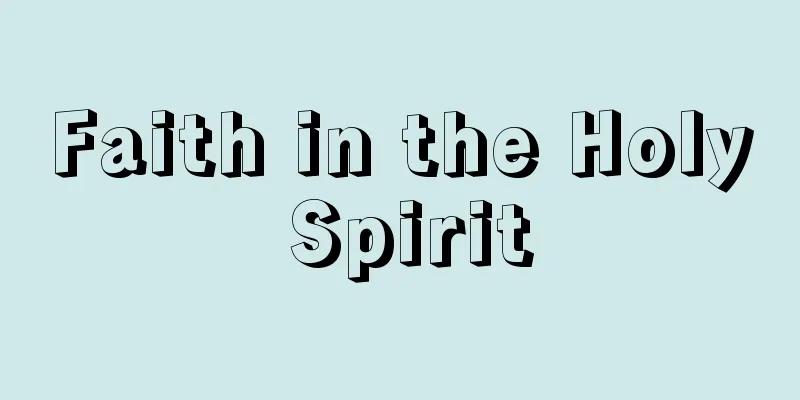Faith in the Holy Spirit

|
The belief that the spirits of people who died unfortunate deaths bring curses and disasters. There is also a belief in worshiping gods who appease and suppress them. In the belief in the soul, the soul is considered to be the most sacred and immortal being, and as long as a part of the soul resides in the human body and remains stable, the person is alive. The state in which the soul and body are united is considered to be alive, and after death, the soul and body gradually separate as the descendants perform the rituals, the body decays, and the soul is reborn. However, in the case of people who died a tragic death such as in an accident, war, or suicide, only the body of the soul is suddenly damaged, and the soul loses a place to rest and becomes a floating spirit. People fear that the floating spirits are trying to enter the bodies of others, or that they will become rice pests and cause poor harvests, so they perform magical ceremonies to send them away. These floating spirits were called "mononoke" in the Heian period, "onryo" (vengeful spirits) or "goryo" (divine spirits) in the Middle Ages, and "muenbotoke" (unattended Buddhas) or ghosts in the early modern period. From the end of the Nara period to the end of the Heian period, natural disasters and epidemics were blamed on the curse of vengeful spirits, and in 863 (Jogan 5), a Goryo-e (goryo-e) ceremony was held at Shinsen-en Garden, and Goryo shrines were built one after another in Gion, Kitano, Tenjin, Murasakino, Imamiya, and other places. The festivals of these shrines are mainly summer festivals, and many of them are spectacular, with floats and stalls paraded around in costumes in what is called "furyu." Many rural events also involve faith in spirits, such as insect-sending ceremonies and road-cutting rope ceremonies, and these influenced folk events up until the early modern period. [Shoji Inoguchi] [Reference] |Source: Shogakukan Encyclopedia Nipponica About Encyclopedia Nipponica Information | Legend |
|
不幸な死に方をした人の霊が、祟(たた)り、災いをもたらすという信仰。またそれをなだめ、抑える神を祀(まつ)る信仰。霊魂信仰では、霊魂がもっとも尊く不滅の存在であるとし、その一部が人体に宿って安定している間、その人は生きていると考えた。霊肉そろった状態が生であり、死後は子孫の祀りを受けてしだいに霊肉が分離し、肉体は朽ちて霊魂は再生するという考え方である。ところが事故死、戦死、自殺など非業(ひごう)の死を遂げた人の場合、霊肉のうち肉体だけが突然損なわれるわけで、霊魂は安定する場所を失って浮遊霊となる。その浮遊霊が他人の肉体に入ろうと、ねらっているのではないかと恐れたり、稲の害虫になって凶作の原因になるとして鎮送の呪術(じゅじゅつ)行事を行ったりする。その浮遊霊のことを、平安時代には物の怪(もののけ)、中世にかけては怨霊(おんりょう)、御霊(ごりょう)、近世には無縁仏(むえんぼとけ)とか幽霊とかいう。奈良時代末から平安時代末にかけて、天変地異や疫病流行があったのを怨霊の祟りとし、863年(貞観5)には神泉苑(しんせんえん)で御霊会(え)が行われ、祇園(ぎおん)、北野(きたの)、天神(てんじん)、紫野(むらさきの)、今宮(いまみや)などの御霊神社も次々に造営された。これら神社の祭礼は夏祭がおもで、山車(だし)、屋台などを繰り出し、風流(ふりゅう)といって仮装して練り歩くなど、華々しい形をとるものが多い。農村行事にも虫送り、道切り縄など御霊信仰に関連するものが多く、近代初期までの民俗行事に影響を与えた。 [井之口章次] [参照項目] |出典 小学館 日本大百科全書(ニッポニカ)日本大百科全書(ニッポニカ)について 情報 | 凡例 |
<<: Imperial Household - Goryonin
>>: Magistrate of the Imperial Estate - Goryoshobugyo
Recommend
Common land - Iriaichi
In the Middle Ages, village communities and the lo...
Calliope
...The center of worship was Mount Helikon in Pie...
Iberis semperbirens (English spelling)
… [Eiichi Asayama]. … *Some of the terminology th...
Peterborough (English spelling)
A city in central eastern England. It is a unitary...
Rental hoe - Kashiguwa
This refers to the practice of people other than f...
Rare metal
...These metals, including steel, aluminum, coppe...
Picture Mie - Emen no Mie
A type of mie in Kabuki theatre. The actors on sta...
Catania - Catania (English spelling)
The capital of Catania Province in the Autonomous...
Five directions and five parts - Gohogobu
The military division of the provinces and capital...
Nishi Amane
Year of death: January 31, 1897 Year of birth: 182...
Fukuwarai - Fukuwarai
A type of paper toy (gangu). It consists of a pie...
Creel
Also written as "fish basket." A contain...
Buried Cultural Property - Maizo Bunkazai
Buried cultural property means cultural property ...
Epoxy resin - Epokisijushi (English spelling) epoxy resin
A general term for synthetic resins with relative...
The Thirty Tyrants
An oligarchic government was established in Athens...

![A cappella (English spelling) a cappella [Italy]](/upload/images/67cad106de07a.webp)







